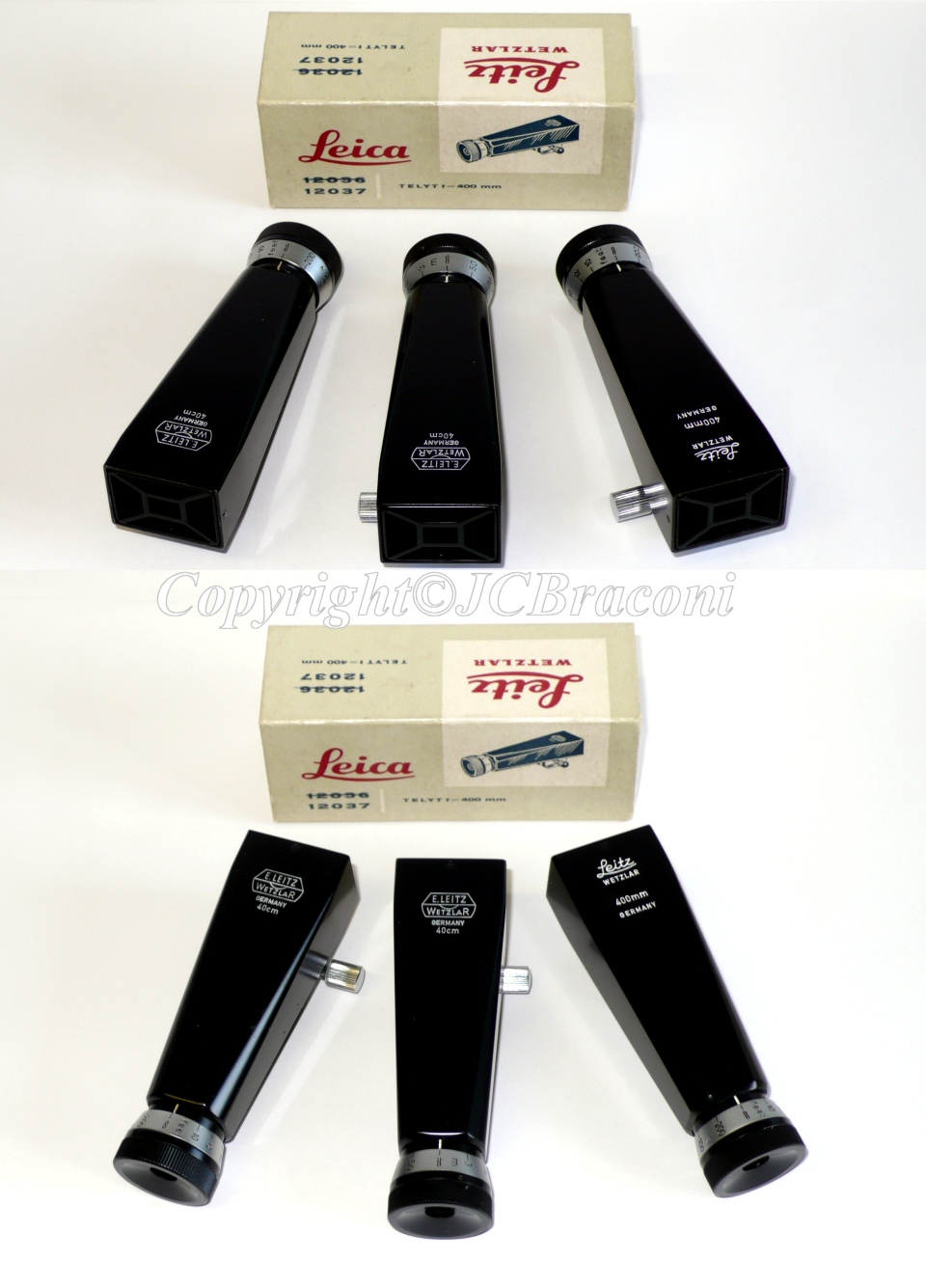|
|
The universal viewfinder VIDOM.
From 1933 to 1939.
The principle is based on two
inside black blades which by turning the outside ring make a shape
corresponding to the field of view matching with the lenses. Image inside is not horizontally
rectified, L is on the R. You have to turn one quarter of a turn the knurled
rear ring to aim in a vertical camera standing.
Some are illustrated here with
from l to r :
the first model black paint and
nickel, with plain nose ( no ring ) parallax correction cam in feet scale.
Second model black paint and
nickel, with ring (or collar depend the authors) parallax correction cam in feet
scale.
Third model black paint and
chrome, with ring, parallax correction cam in feet scale.
Fourth model all chrome, with
ring, parallax correction cam in meter scale.
Fifth model all chrome, with ring,
parallax correction cam in feet scale.
Sixth model black paint and
chrome, with ring, parallax correction cam in meter scale.
The adjustable viewfinder inside
shape rings are all engraved all the same with 3,5-5-7,3-9-10,5 and 13,5 cm the shortest line is for adjusting
the viewfinder blades for short distances, < 2 m.
|
|
the VIOOH universal viewfinder an
evolution from the VIDOM by adding a set of prisms make a rectified horizontally
image.
From 1940 to 1964.
|
|
Some are illustrated here with
from L. to R. :
A lyre shape with enhanced top,
parallax correction cam in feet scale under base serial numbered.
A lyre shape with enhanced top,
parallax correction cam in feet scale under base serial unnumbered. Black nose.
A lyre shape with straight top,
parallax correction cam in meter scale.
A straight side shape parallax
correction cam in feet scale. Four digit serial number.
A straight side shape parallax
correction cam in feet scale. Early 5 digit serial number.
A straight side shape parallax
correction cam in meter scale.
A straight side shape parallax
correction cam in feet scale, last production,
Leitz
white paint inletted , 99058 serial numbered.
The lyre shaped models wear the
focal lens 3,5-5-7,3-9-13,5 engraved on the adjustable ring.
The straight side shaped models wear the focal lens 3,5-5-8,5-9-13,5 engraved on
the adjustable ring.
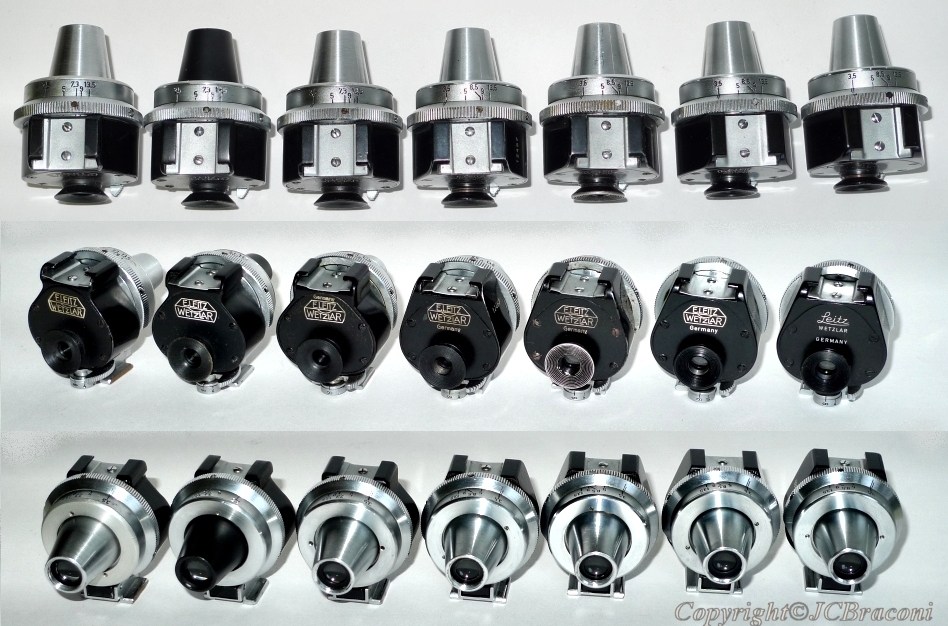
A lyre shape with straight
top, with U.S.A. under the condenser shape E. LEITZ NEW YORK logo, rear plate
engraved.
Parallax correction cam in feet scale.
Four digit serial numbered. Note the hem around the rear body. Parallax correction cam in feet scale.
The focal lens frame selector ring
engraved with 35-50-73-9-135 and 127 for the Velostigmat Vollensack lens.
A lyre shape with straight top, with Germany
engraved under the condenser shape E LEITZ WETZLAR logo.
Parallax correction cam in m scale.
The focal lens frame selector ring
engraved with 3,5-5-7,3-9-13,5.
A
straight side shape with GERMANY in capital letters
engraved under the condenser shape
E LEITZ WETZLAR logo. Parallax correction cam in m scale.
The focal lens frame selector ring
engraved with 3,5-5-8,5-9-13,5
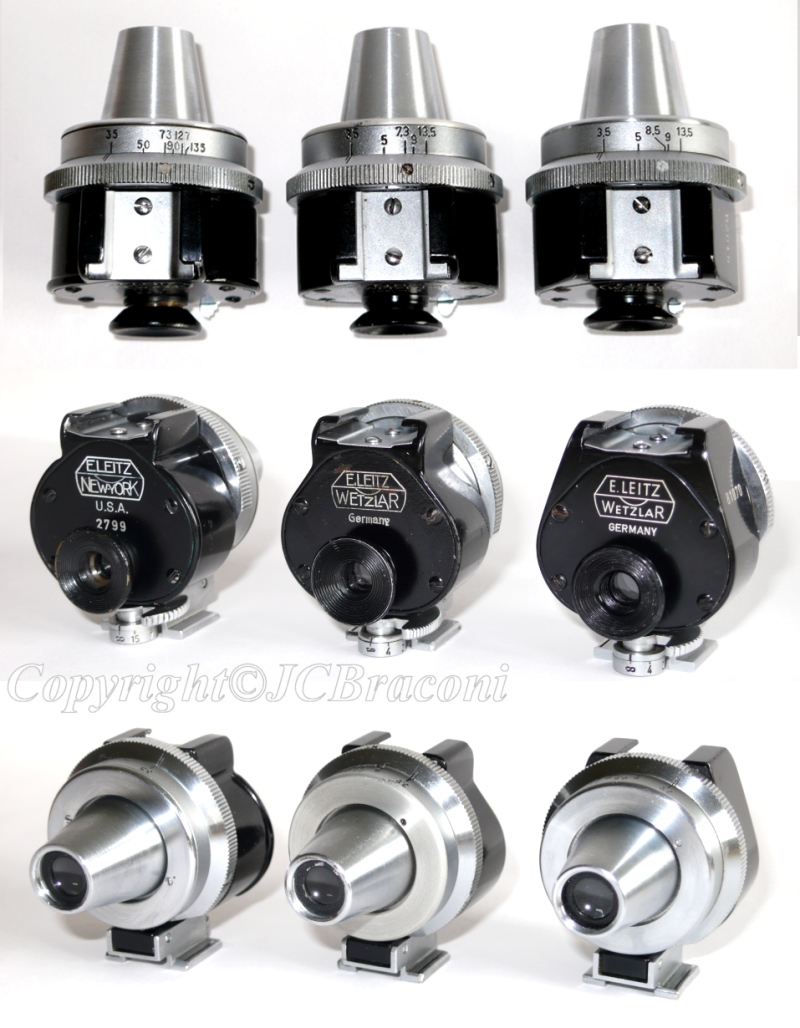
VIOOH's with carton boxes early and lately shape and
colors
note the eye sight correction lens on the first one
|
|
|
|
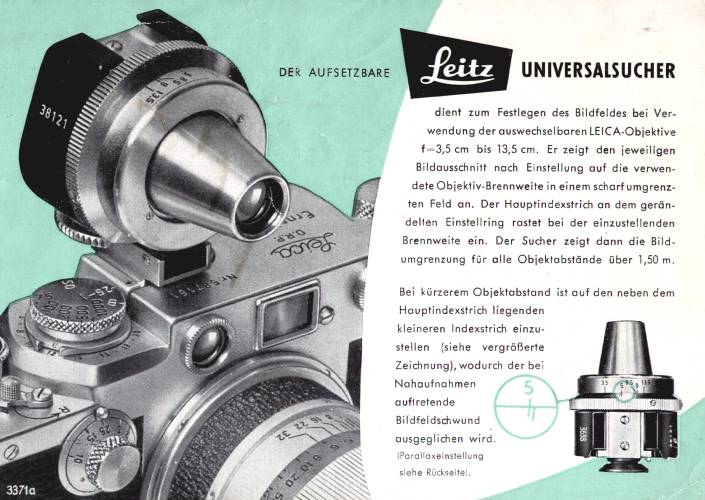 |
 |
 |
|
The VISOR (1931) the first “universal” viewfinder designed by Oskar Barnack to accompany the new Leica I with interchangeable lens (Type C) with 35-50-135 frames, had 16 variations due to different inside frames combinations.
The reflecting (waist level) viewfinders first appeared in 1932 and available to mid WWII
The AUFSU with and without accessory shoe black enamel
The AYOOC (1936) is an AUFSU with an extra negative front lens could be swung to convert the field of view to 3.5cm. The same system was used for the 2.8 cm code AHOOT
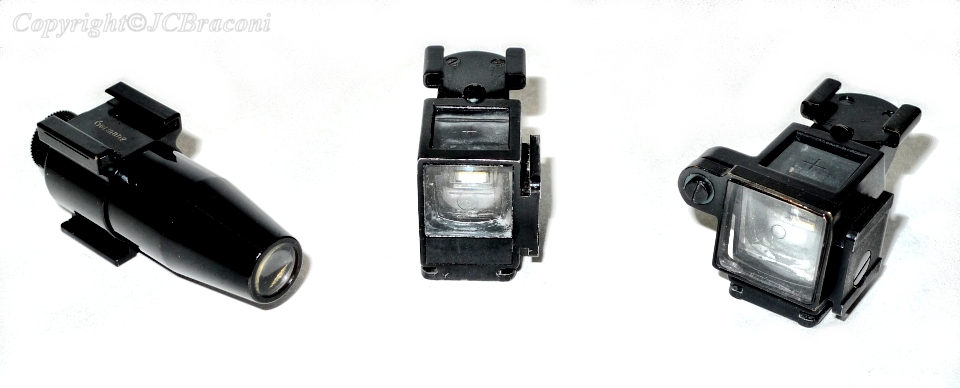
Right angle viewfinders
The WINKO (1929) early models with
large eyecup,
First model for Leica I had to be
inserted from the front of the camera into the accessory shoe, or on a special
lens cap.
Second model to be inserted by the
back side of the camera into the accessory shoe.
The WINTU (1933) with swing down
prism for use with rangefinder black or chrome.
In the background respective
leather cases and genuine red carton boxes.
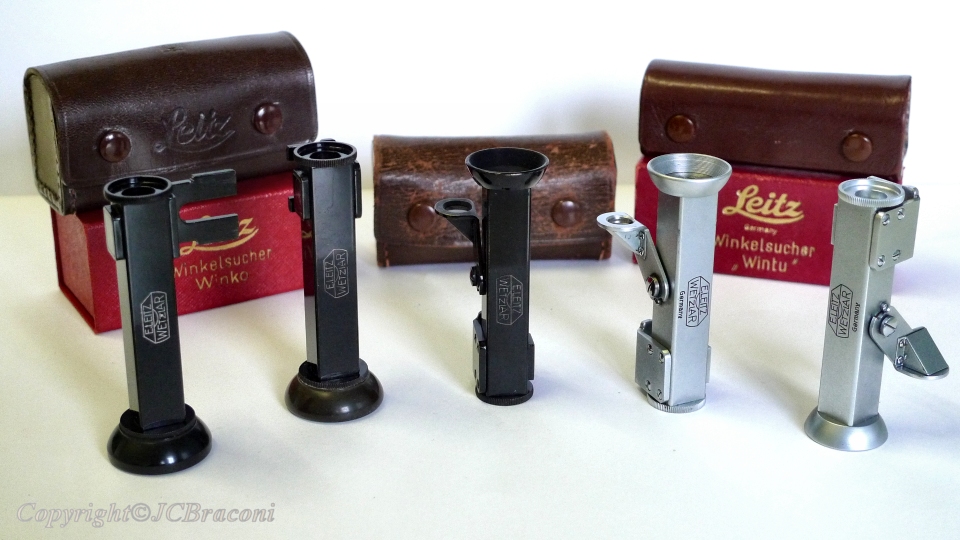
The Frames Viewfinders
The frame viewfinders SFTOO /
12034B and SQTOO /12037 to be used on the Visoflex I or, in place of it,
by the TZOON or TXBOO adapters as sporting viewfinder when using Telyt's 200mm
or 400mm tele-objectives lenses.
They
consists of a pyramidal shape tube with, on one extremity, a rectangular metal
frame and on the other one a parallax adjustable viewfinder based on a simple
hole, off of center drilled disc .
For illustrations some frame
viewfinders with different engravings, Leitz Wetzlar in different characters, cm
or mm and also different scale, meter and feet units parallax scales. Included
are genuine carton boxes.
SFTOO / 12034B
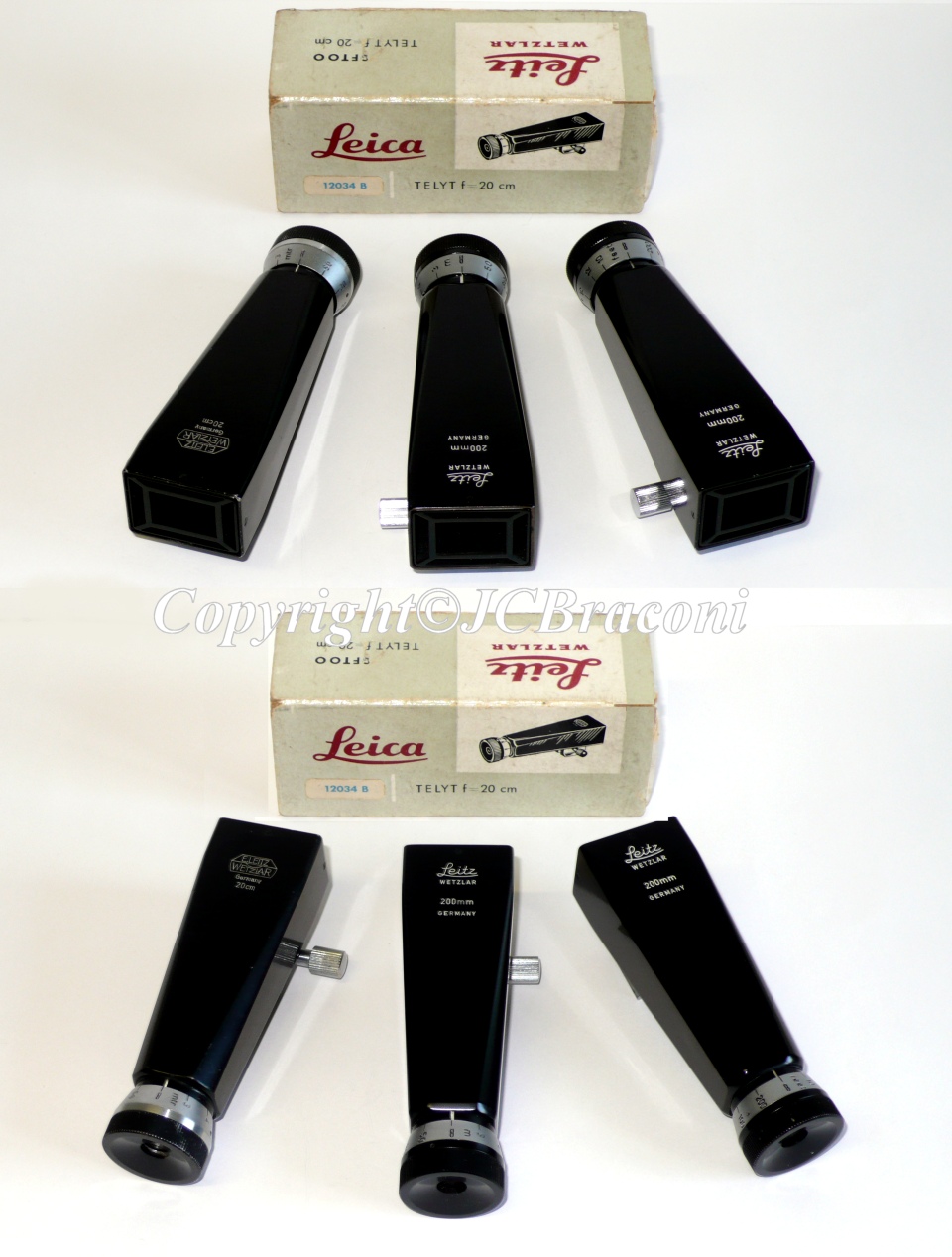
SQTOO /12037
